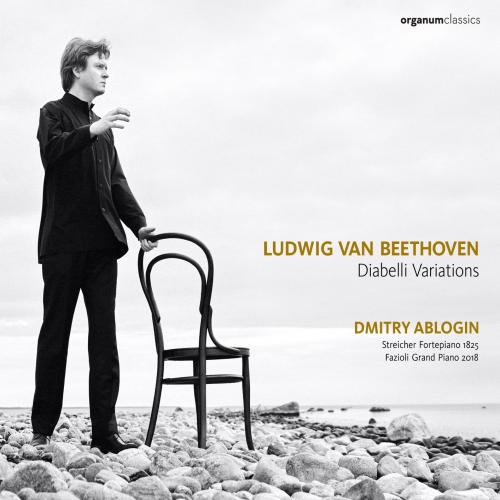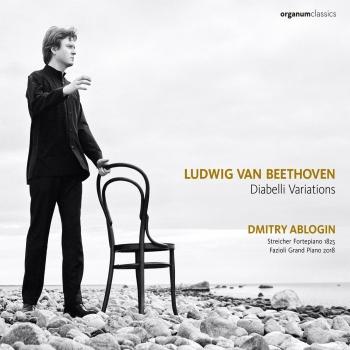
Beethoven: Diabelli Variations Dmitry Ablogin
Album info
Album-Release:
2022
HRA-Release:
23.12.2022
Label: Organum Classics
Genre: Classical
Subgenre: Instrumental
Artist: Dmitry Ablogin
Composer: Ludwig van Beethoven (1770–1827)
Album including Album cover Booklet (PDF)
- Ludwig van Beethoven (1770 - 1827): 33 Variations on a Waltz by Anton Diabelli for Piano, op. 120: CD 1:
- 1 Walzer · Waltz. Vivace 00:52
- 2 Variation 1. Alla marcia maestoso 01:31
- 3 Variation 2. Poco allegro 00:43
- 4 Variation 3. L’istesso tempo 01:27
- 5 Variation 4. Un poco più vivace 01:03
- 6 Variation 5. Allegro vivace 01:00
- 7 Variation 6. Allegro ma non troppo e serioso 01:49
- 8 Variation 7. Un poco più allegro 01:09
- 9 Variation 8. Poco vivace 01:20
- 10 Variation 9. Allegro pesante e risoluto 01:52
- 11 Variation 10. Presto 00:37
- 12 Variation 11. Allegretto 01:13
- 13 Variation 12. Un poco più moto 01:00
- 14 Variation 13. Vivace 01:10
- 15 Variation 14. Grave e maestoso 05:11
- 16 Variation 15. Presto. Scherzando 00:36
- 17 Variation 16. Allegro 01:02
- 18 Variation 17. Allegro 01:03
- 19 Variation 18. Poco moderato 01:49
- 20 Variation 19. Presto 00:54
- 21 Variation 20. Andante 02:27
- 22 Variation 21. Allegro con brio - Meno allegro - Tempo primo - Meno allegro 01:14
- 23 Variation 22. alla „Notte e giorno faticar“ da Mozart. Allegro molto 00:57
- 24 Variation 23. Allegro assai 00:59
- 25 Variation 24. Fughetta. Andante 02:36
- 26 Variation 25. Allegro 00:42
- 27 Variation 26. ohne Bezeichnung · without indication 01:40
- 28 Variation 27. Vivace 01:02
- 29 Variation 28. Allegro 01:07
- 30 Variation 29. Adagio ma non troppo 01:16
- 31 Variation 30. Andante, sempre cantabile 02:13
- 32 Variation 31. Largo molto, espressivo 05:24
- 33 Variation 32. Fuga. Allegro - Poco adagio 03:51
- 34 Variation 33. Tempo di minuetto moderato (ma non tirarsi dietro) 04:21
- CD: 2
- 35 Walzer · Waltz. Vivace 00:52
- 36 Variation 1. Alla marcia maestoso 01:27
- 37 Variation 2. Poco allegro 00:45
- 38 Variation 3. L’istesso tempo 01:25
- 39 Variation 4. Un poco più vivace 01:05
- 40 Variation 5. Allegro vivace 00:56
- 41 Variation 6. Allegro ma non troppo e serioso 01:47
- 42 Variation 7. Un poco più allegro 01:08
- 43 Variation 8. Poco vivace 01:19
- 44 Variation 9. Allegro pesante e risoluto 01:58
- 45 Variation 10. Presto 00:39
- 46 Variation 11. Allegretto 01:12
- 47 Variation 12. Un poco più moto 01:01
- 48 Variation 13. Vivace 01:05
- 49 Variation 14. Grave e maestoso 05:06
- 50 Variation 15. Presto. Scherzando 00:36
- 51 Variation 16. Allegro 01:02
- 52 Variation 17. Allegro 01:04
- 53 Variation 18. Poco moderato 01:47
- 54 Variation 19. Presto 00:54
- 55 Variation 20. Andante 02:23
- 56 Variation 21. Allegro con brio - Meno allegro - Tempo primo - Meno allegro 01:16
- 57 Variation 22. alla „Notte e giorno faticar“ da Mozart. Allegro molto 00:55
- 58 Variation 23. Allegro assai 00:56
- 59 Variation 24. Fughetta. Andante 02:28
- 60 Variation 25. Allegro 00:44
- 61 Variation 26. ohne Bezeichnung · without indication 01:41
- 62 Variation 27. Vivace 01:03
- 63 Variation 28. Allegro 01:08
- 64 Variation 29. Adagio ma non troppo 01:19
- 65 Variation 30. Andante, sempre cantabile 02:05
- 66 Variation 31. Largo molto, espressivo 05:19
- 67 Variation 32. Fuga. Allegro - Poco adagio 03:44
- 68 Variation 33. Tempo di minuetto moderato (ma non tirarsi dietro) 04:19
Info for Beethoven: Diabelli Variations
Published almost two centuries ago in 1823, the Diabelli Variations are more than just a major work in Ludwig van Beethoven’s oeuvre and in the history of piano music. Rather, they are among those exceptional works of music history that simply cannot be classified and – as Igor Strawinsky wrote in amazement about the Grand Fuge for string quartet composed three years later – could well have been created on a satellite in outer space. Despite only daring to première the Diabelli Variations in Berlin in 1856 and focussing on them throughout his life as an artist and publisher, Hans von Bülow was correct in his prediction that this work would provide “musical brain food for generations” – and not just for pianists and their audiences, but for music historians and theorists too. As such, countless works have been dedicated to the origins, intention, structure and (biographical) symbolism of the work – not least, in the tradition of von Bülow, by the pianists themselves, as demonstrated by the editions and statements of greats such as Artur Schnabel, Alfred Brendel and Rudolf Buchbinder.
In a ground-breaking study, the American musicologist and pianist William Kinderman was able to show, by examining the sketches, how convoluted the development work was until Beethoven ultimately arrived at the finished piece. This also reflects the fact that the original reason for its creation can be traced back to a request made by the Viennese composer and publisher Anton Diabelli, who asked prominent composers and pianists of the time to each write a variation on a theme stipulated by him for inclusion in an anthology: a simple, yet catchy waltz for piano and two hands. Beethoven, however, composed 33 variations, and it took him four years to complete as a result of various interruptions since he was also working on his final three piano sonatas opp. 109–111 and the Missa Solemnis – due to their size, these works were then initially published as a separate volume. This creative transformation and, in part, lustful-parodic “destruction” of the theme resulted in a kaleidoscope of variations, ranging from étude to fugue, from masked chorale to melancholy Adagio, thereby shattering all previous standards associated with the piano variation genre, which Beethoven himself had already significantly expanded, yet not transcended, with the three variation cycles op. 34, op. 35 (Eroica Variations) and WoO 80.
As a true point of comparison, another exceptional work must also be considered, namely Bach’s Goldberg Variations, whose original title “Aria with different variations” is also referenced in Beethoven’s official title: “33 Veränderungen über einen Walzer für das Piano-Forte” (33 Variations on a Waltz for the Pianoforte). The key to our enduring fascination with this work lies in the incessant broadening of horizons with which Beethoven not only refers in the Diabelli Variations to both historical and personal development, but also almost experimentally tries out new possibilities of composing for and interacting with the piano. Another aspect can be heard in this double recording by Dmitry Ablogin, played on both a historical and a modern grand piano: the Diabelli Variations can be played as timeless music on either instrument. This is also because Beethoven himself continuously adapted the technical and tonal requirements of his piano movement to match accomplishments in piano construction. Therefore, the rendition played on the 1825 top-keyed grand piano constructed by Nanette Streicher, who may even have presented the instrument to her friend Beethoven, demonstrates not so much the limitations of this wonderful instrument but rather showcases its striking range of expression. On a Fazioli – as the pinnacle of today’s grand piano design, conceived for entirely different works, spaces and publics – perhaps the pianist’s most refined task is not to be seduced by the possibilities of virtuoso and dynamic development, thereby neglecting the unique diversity of this subtle musical and tonal microcosm. (Wolfgang Rathert)
Dmitry Ablogin, fortepiano and piano
Dmitry Ablogin
is one of today's most brilliant and innovative keyboard artists.
He studied with Vladimir Tropp at the Gnessin Academy in Moscow, from which he graduated with honours in 2012. He continued his education in Germany, studying fortepiano with Jesper B. Christensen at the Hochschule für Musik und Darstellende Kunst in Frankfurt.
Laureate of the 1st International Chopin Competition on Period Instruments in Warsaw (2018), Dmitry has won prizes in numerous piano competitions, including the Nikolai Rubinstein in Paris, Vera Lotar-Shevchenko in Novosibirsk, German Piano Open in Hanover and Musica Antiqua in Bruges. In October 2021 Dmitry has won the 10th International German Piano Award and made his debut at the Alte Oper Frankfurt.
Dmitry has performed in Switzerland, Italy, Spain, Germany, Denmark, Poland, Russia, France, the US at the Miami International Piano Festival and in Warsaw at the renowned festival “Chopin and his Europe”.
In addition to performing around the world, he is teaching piano and fortepiano at the Hochschule für Musik und Darstellende Kunst in Frankfurt.
Booklet for Beethoven: Diabelli Variations










